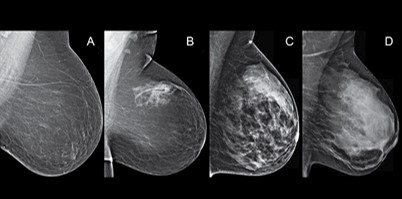Phone Appointment
[smartblock id=45]WhatsApp Appointment
[smartblock id=46]March 2023
What Is Breast Density?
A woman’s breast has three kinds of tissue – Fibrous tissue, glandular tissue and fatty tissue. Breast density is a measure of how much fibrous and glandular tissue there is in your breast, as compared to fat tissue. There are 4 categories of breast density:

- A: Almost entirely fatty indicates that the breasts are almost entirely composed of fat. About 1 in 10 women has this result.
- B: Scattered areas of fibroglandular density indicates there are some scattered areas of density, but the majority of the breast tissue is nondense. About 4 in 10 women have this result.
- C: Heterogeneously dense indicates that there are some areas of nondense tissue, but that the majority of the breast tissue is dense. About 4 in 10 women have this result.
- D: Extremely dense indicates that nearly all of the breast tissue is dense. About 1 in 10 women has this result.
Women with breasts that are classified as heterogeneously dense or extremely dense are considered to have dense breasts. About half of women undergoing mammograms have dense breasts.
Mammogram reports include information about breast density. Your health care provider can also tell you if your mammogram shows that you have dense breasts.
Why Is Breast Density Important?
Having dense breasts affects you in two ways:
- Dense breast tissue makes it more difficult to interpret a mammogram, since cancer and dense breast tissue both appear white on a mammogram. Very dense breasts may increase the risk that cancer won’t be detected on a mammogram.
- Women with dense breasts have a higher chance of getting breast cancer. The more dense your breasts are, the higher your risk.
Who Is More Likely to Have Dense Breasts?
You are more likely to have dense breasts if you:
- Are younger.
- Are taking hormone replacement therapy.
- Have a lower body mass index.
What Should I Do If I Have Dense Breasts?
Talk to your doctor about your personal risk of getting breast cancer. Dense breasts are just one of risk factors for breast cancer. Other factors include your age and family history of cancer.
While it is recommended for women with an average risk of breast cancer to go for regular mammogram testing beginning at age 40, women with dense breasts are sometimes suggested supplemental imaging tests. Discuss with your doctor about how often you should be screened for breast cancer and which tests your doctor recommends.
Supplemental tests for breast cancer screening may include:
- Breast Ultrasound: A machine that uses sound waves to make pictures of areas inside the breast. Ultrasound can be especially helpful in women with dense breast tissue, which can make it hard to see abnormal areas on mammograms. It also can be used to get a better look at a suspicious area that was seen on a mammogram.
- Breast MRI (Magnetic Resonance Imaging): A kind of body scan that uses radio waves and magnets to make detailed pictures of areas inside the breast. Breast MRI is recommended for women with a very high risk of breast cancer.
